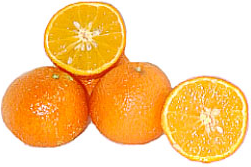


Orlando Tangelos
Estimated Inventory, 28 lbs : 0
Description/Taste
Having very few seeds and easy to peel, this very juicy sweetly tart citrus fruit gets its name because it's a cross between a mandarin and a pummelo or a grapefruit. Round to oval and growing on a large tree, the unusual cup-shaped leaves it produces makes this variety easy to recognize. Medium to large in size, but a bit smaller than the Minneola variety, the fruits measure about two and three-fourths inches to three inches in diameter. Ranging from deep orange to light orange in color, the peel is medium thick and usually has a pebbly surface. It's easy to understand this fruit's popularity after tasting the rich orange colored segments of this special tangelo.
Seasons/Availability
Grown in the southern inland of California, Orlando tangelos are available January to mid-April. Grown in the Arizona and California deserts, this citrus fruit is available mid-December to February. Northern California valleys and northern California inland fruits are available mid-February to mid-May.
Current Facts
All tangelos are either an accidental or deliberate hybrid of any type mandarin orange and either the grapefruit or pummelo, offering the best of both. Many hybrids exist of this loose-skinned fruit and vary in size from a small grapefruit to a tiny orange. Ranging in color from a very deep orange to a yellow-orange, their skins may be also be either quite smooth or very rough, or anything in between. Even though the Orlando tangelo is loved for its great flavor and is the most popular early season tangelo, the most common variety available in the United States is the later Minneola tangelo, easily recognized by its characteristic protruding nipple-shaped stem end. An extended family, the "Nova" is a cross between the popular Clementine tangerine and Orlando tangelo, grown by Dr. Jack Bellows in 1942. First fruiting in 1950, the Nova was later released by the United States Department of Agriculture's Horticultural Field Station, Orlando, Florida, in 1964.
Nutritional Value
An excellent source of vitamin C, tangelos provide dietary fiber.
Applications
Not only great for snacking, tangelos give flavorful life to both fruit and vegetable salads. Use as edible decorative garnish. Add to gelatin molds. To store, keep at room temperature. Refrigerate for longer storage.
Geography/History
In 1897, Dr. Walter T. Swingle at Eustis, Florida and Dr. Herbert J. Webber at Riverside, California, in 1898 were the first to produce the crosses that resulted in the tangelo fruit. Because they are so different from other citrus fruits, they were put in a class by themselves named Citrus X tangelo J. Ingram and H. E. Moore, C. X paradisi X C. reticulata. The Orlando tangelo, the most hardy, is the result of the Bowen or Duncan grapefruit pollinated with the Dancy mandarin by Dr. Swingle in 1911. The Orlando, of course, is a very good commercial fruit grown in Florida. Now grown in parts of California, but sensitive to frost, this fruit doesn't survive very well in the cool coastal areas.




